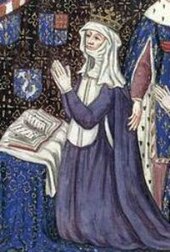Blanka of Navarre (France)
Blanka of Navarre (* around 1331, † October 5, 1398 in Neaufles-Saint-Martin ) was through her marriage to Philip VI. briefly Queen of France.
Life
She was a daughter of Philip III. , King of Navarre ( de iure uxoris ), and Joan II , Queen of Navarre in her own right, consequently the sister of King Charles the Evil one .
Initially, it was intended for a connection with a Spanish ruling house. But when both Queen Johanna († 1348 or 1349) and Crown Prince Johann's wife , Jutta of Luxembourg († September 11, 1349), died in France in quick succession, French diplomacy succeeded in bringing about a change in course at the court of Navarra: Blanka of Navarre was now to marry the French crown prince.
When she arrived in Paris, however, Philip VI, 40 years her senior, decided not to leave her to his son, but to marry himself. A replacement was found for Johann in Johanna von Boulogne , heiress of the County of Auvergne and the County of Boulogne . The weddings took place in quick succession: On January 29, 1350, Philipp and Blanka married in Brie-Comte-Robert , on February 19, Johann and Johanna in Nanterre .
However, Blanka's marriage lasted only a short time, since Philip VI. himself died on August 22, 1350. At that time Blanka was pregnant, in May 1351 she gave birth to a daughter, Johanna (Jeanne), called Blanche († September 16, 1371).
The widow, who was not yet 20 years old, moved into her residence in Paris in a house in the Rue de la Vieille-Tixeranderie, which was named after her Hôtel de la Reine Blanche and which later belonged to her nephew Peter of Navarre , Count von Mortain , passed over. In the years after 1354 she played a role again at court when she tried to reconcile the new King John II, with whom she was on friendly terms despite the failed engagement, and her brother Charles the Evil One. This relationship was the reason that she was in danger in the uprising of the Jacquerie in 1358.
Blanka of Navarre refused a second marriage, now with Peter of Castile , later retired to Neaufles-Saint-Martin near Gisors and also rarely appeared at court. She died in her refuge on October 5, 1398 after 48 years of widowhood and was buried in the Saint-Denis basilica . Her will from the same year lists the works of art that were in her possession, including some manuscripts that have survived.
literature
German:
- Detlev Schwennicke: European Family Tables , Volume II
- Gerd hits: The French queens , Regensburg, 1996, ISBN 3-7917-1530-5
French:
- Jean Favier : Dictionnaire de la France médiévale , Paris, 1993, Fayard, ISBN 2-213-03139-8
- Christian Bouyer: Dictionnaire des reines de France , Paris, 1992, Librairie Académique Perrin, ISBN 2-262-00789-6
Web links
Footnotes
- ↑ Other sources (Schwennicke, Europäische Stammtafeln Volume II (1984), Plate 22, and Gerd Hit in "The French Queens") incorrectly state Neauphle-le-Château west of Versailles.
- ↑ Here, Johann von Aragon, Duke of Girona ( Lexicon of the Middle Ages ) and Hereditary Prince Peter of Castile are named as “betrothed” (Gerd hits in “The French Queens”)
- ↑ hit, s. o., specifies January 29, 1349 as the date for this process, but contradicts himself because Johann was still married at this point in time.
- ↑ The street fell victim to a district renovation in the 19th century. Your old French name Tixeranderie was derived from the local weavers (French: tisserand). In Jean Favier's "Dictionnaire de la France médiévale" erroneously called Tixanderie. The city map from the 14th century and the Nomenclature des voies de Paris ( Memento of the original of August 18, 2007 in the Internet Archive ) Info: The archive link has been inserted automatically and has not yet been checked. Please check the original and archive link according to the instructions and then remove this notice. occupy Tixeranderie.
| predecessor | Office | Successor |
|---|---|---|
| Joan of Burgundy |
Queen of France 1350 |
Johanna of Auvergne |
| personal data | |
|---|---|
| SURNAME | Blanka of Navarre |
| BRIEF DESCRIPTION | Queen of France |
| DATE OF BIRTH | around 1331 |
| DATE OF DEATH | October 5, 1398 |
| Place of death | Neaufles-Saint-Martin |
